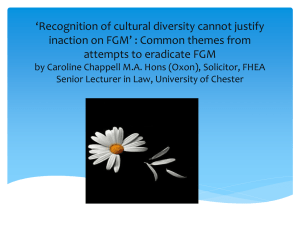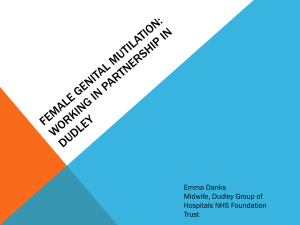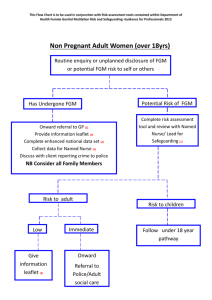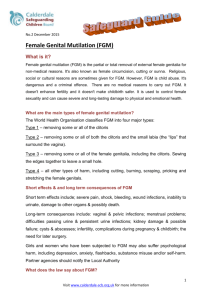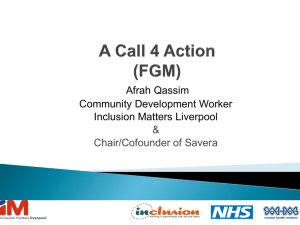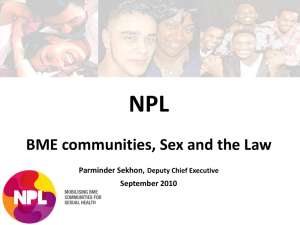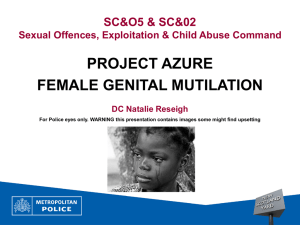FGM Reporting Flowchart for Pregnant Women
advertisement
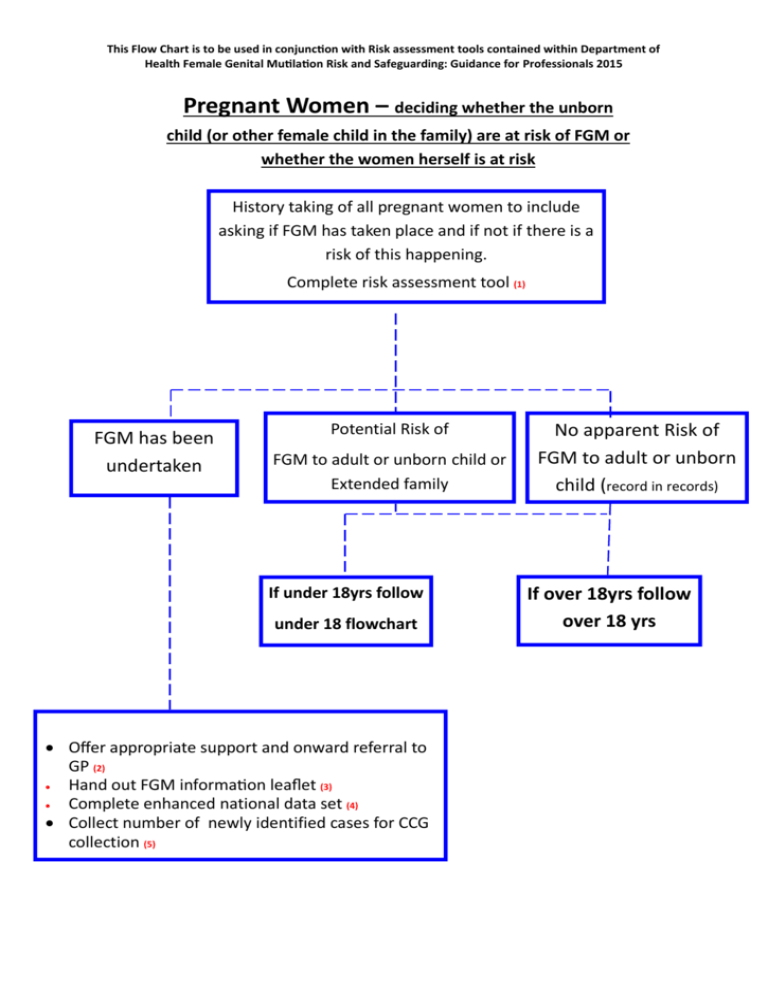
This Flow Chart is to be used in conjunction with Risk assessment tools contained within Department of Health Female Genital Mutilation Risk and Safeguarding: Guidance for Professionals 2015 Pregnant Women – deciding whether the unborn child (or other female child in the family) are at risk of FGM or whether the women herself is at risk W History taking of all pregnant women to include asking if FGM has taken place and if not if there is a risk of this happening. Complete risk assessment tool (1) FGM has been undertaken Potential Risk of FGM to adult or unborn child or Extended family If under 18yrs follow under 18 flowchart Offer appropriate support and onward referral to GP (2) Hand out FGM information leaflet (3) Complete enhanced national data set (4) Collect number of newly identified cases for CCG collection (5) No apparent Risk of FGM to adult or unborn child (record in records) If over 18yrs follow over 18 yrs pathway 1. Risk Assessment Tool for Pregnant Women Part One (a): PREGNANT WOMEN Date:_________ Completed by:___________________ This is to help you make a decision as to whether the unborn child (or other female children in the family) are at risk of FGM or whether the woman herself is at risk of further harm in relation to FGM. Indicator CONSIDER RISK Woman comes from a community known to practice FGM. Woman has undergone FGM herself. Husband/partner comes from a community known to practice FGM. A female family elder is involved/will be involved in care of children /unborn child or is influential in the family. Women/family has limited integration in UK community. Women and/or husband/partner have limited/no understanding of harm of FGM or UK law. Women’s nieces or siblings and/or in-laws have undergone FGM. Woman has failed to attend follow-up appointment with an FGM clinic/FGM related appointment. Woman’s husband/partner/other family members are very dominant in the family and have not been present during consultations with the woman. Woman is reluctant to undergo genital examination. SIGNIFICANT OR IMMEDIATE RISK Woman already has daughters who have undergone FGM. Woman requesting reinfibulation following child birth. Woman is considered to be a vulnerable adult and therefore issues of mental capacity and consent should be considered if she found to have FGM. Woman says that FGM is integral to cultural or religious identity. Family are already known to social care services – if known, and you have identified FGM within a family, you must share this information with social services. Yes Initial/On-going Assessment ACTION No Details Ask more questions - if one indicator leads to potential area of concern, continue the discussion in this area. Consider risk – if one or more indicators are identified, you need to consider what action to take. If unsure whether the level of risk requires referral at this point, discuss with your named/designated safeguarding lead. Significant or immediate risk – if you identify one or more serious or immediate risk, or the other risks are, by your judgment, sufficient to be considered serious, you should look to refer to Social Services/CAIT Team/Police/MASH, in accordance with your local safeguarding procedures. If the risk of harm is imminent, emergency measures may be required and any action taken must reflect the required urgency. In all cases:• Share information of any identified risk with the patient’s GP. • Document in notes. • Discuss the health complications of FGM and the law in the UK. 2 Client may need referral for counselling, surgery etc. make referral to GP 3 Information Leaflet 4 For further information on hscic FGM enhanced dataset visit www.hscic.gov.uk/isce/publication/scci2026 5 Inform your named nurse/safeguarding lead that you have seen newly identified case of FGM. Named Nurses/Lead for Safeguarding to submit numbers to Designated Nurses bi- monthly
